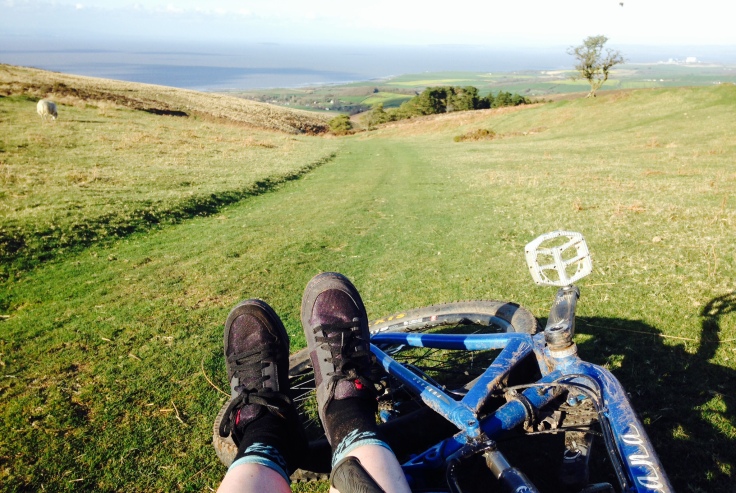The sun is shining, the hawthorn is in blossom, green leaves are budding in trees left right and centre and the woodland floor is carpeted with wild garlic flowers, wood anemone and bluebells. Spring is most definitely here.
And the reason I notice it is because I am out in it, regularly and often, on my bike.
The fact that cycling gets you out into the great outdoors is one of the best things about it, in my humble opinion. Being outside is good for the soul, and good for the mind. It may sound like a cliché, but you really do notice and connect more with what’s happening in the natural world when you ride a bike, compared to say a being in a car or bus.
The first spring after I started cycling again as an adult was amazing. I was riding the same route, day in day out, and because of this I could see things changing day by day. I remember my awe when over the course of one week the trees went from bare and leafless to clothed in vivid green. It was astonishing.
It sounds obvious, but even though I knew spring sprang every year, there’s a difference between knowing it and then seeing it with your very eyes and understanding what that means.
Which is why I think cyclists make very good phenologists. Or could do, if we could only harness their united observational power.
Phenology, just to clear up any misunderstandings, is the science of spring. More accurately, it’s the study of natural plant and animal cycles, usually associated with seasons, and in particular the first appearance of things in a year– hence the spring connection.
The word phenology does sound like and look like phrenology, which is the pseudoscientific study of the link between head shape and personality. Careful with that extra ‘r’!

Phenology has become a topical science again because of its links to climate change research. As our climate shifts, affecting our weather, it will also have an impact on our seasonal variations. This in turn will have an effect on how plants and animals, as they respond to these changes.
For example, warmer weather earlier in spring might mean that spring flowers or insects like butterflies emerge earlier. It sounds nice, put in that way, but it can have a knock on effect. For example, if warm weather brings an animal out of hibernation but it’s usual food source hasn’t yet grown or emerged, it can be left with nothing to eat and the population may suffer as a result. As these changes happen, natural systems can get out of sync.
Climate scientists and meteorologists have been observing things like temperature and rain fall for decades, and there’s a lot of evidence that springs are warmer and earlier than they used to be. But how do you know if this really is having an effect on the environment? After all, lots of organisms are adaptable, right? That comes down to observation of the animals and plants themselves, highlighted perfectly by programs like Springwatch.
People have been recording the first appearance of certain birds, flowers, insects and so on for a very long time, so we’ve got records going back a long way that show things like oak trees are growing leaves earlier, and rooks are building their nests earlier.
And although organisms are adaptable, the question is whether the speed they can adapt can keep pace with the speed things are changing at. If they can’t, then…
The more evidence you have, the more you can work out and more surety you have with your conclusions. To have more evidence, you need more people out there collecting it. There’s a lot more of the general public out there than there are scientists, and a huge percentage of them are as fascinated by the natural world, myself included.
This fact, and a growing recognition that science isn’t just the domain of professional scientists, has led to the birth of ‘Citizen Science’, a way of coordinating the efforts of the general public into helping research or study specific projects and questions. So now, if the fancy takes you, you can get involved in everything from spotting planets to studying birds. It’s brilliant!
So why not harness the power of cyclists in a similar way?
Think about it; every day, hundreds of cyclists pedal their way into work through cities, suburbs and countryside. They usually ride the same routes, often at the same time of day. They’re perfectly placed to make observations and spot patterns. All you’d need to do is have a guide for what to look out for, and a simple way of inputting that data once the cyclist arrived at their destination. (Obviously, I’d recommend against anything that would adversely affect a cyclists concentration while on the road – safety first and always!)
Actually, my suggestion isn’t a new one. I’ve heard of a project (I’ll get the details and add later when I find them!) that aimed to record insect sounds as a population monitoring tool by attaching a small portable microphone and recorder to the front of bicycles. The idea was the cyclist would go about his or her business, and the microphone would pick up the sound of the insects he or she passed. Quite an elegant idea, I reckon.
Sadly, I don’t know of any other projects that are recruiting cyclists as citizen scientists at the moment – if you know of any, pop them in the comments below!
So for now, I’ll just enjoy my bicycle rides and my own nature observations as I go. Happy spring cycling!

April 26, 2015 at 6:07 pm
Splatter project were looking for roadkill reports – not specifically from cyclists, but we’re probably best placed to observe!
LikeLike